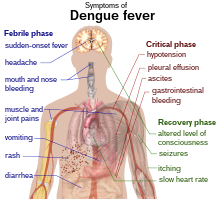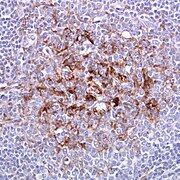Portal:Viruses/Selected article
The following articles are currently featured as the Selected disease at the Viruses Portal. To suggest an article for inclusion, use the suggestions page
Portal:Viruses/Selected article/1
Dengue is transmitted by several species of
Portal:Viruses/Selected article/2
Depictions in ancient art show that the disease has existed for thousands of years. The virus was an
Portal:Viruses/Selected article/3
Smallpox probably emerged in human populations in about 10,000 BC; the mummified body of Egyptian pharaoh
Portal:Viruses/Selected article/4
is a rare complication which can be life-threatening.
Influenza spreads around the world in seasonal epidemics, resulting in about 3–5 million cases of severe illness annually, and about 250,000–500,000 deaths, mainly in the young, the old and those with other health problems. Annual influenza vaccinations are recommended for those at high risk. Sporadic influenza pandemics have been recorded since at least the 16th century. The Spanish flu pandemic of 1918–20 is estimated to have killed 50–100 million people.
Portal:Viruses/Selected article/5

Acute infection is often asymptomatic but can cause
Portal:Viruses/Selected article/6
After initial infection, virus particles are transported along
Portal:Viruses/Selected article/7
The
Symptoms include
Portal:Viruses/Selected article/8
Shingles, or herpes zoster, is a painful skin rash with blisters that, characteristically, occurs in a stripe limited to just one side of the body. The rash usually heals within 2–5 weeks, but around one in five people experience residual nerve pain for months or years.
Shingles is caused by
Around a third of the population will develop shingles. Repeated episodes are rare. In the United States, about half the cases occur in people aged 50 years or older. Vaccination at least halves the risk, and prompt treatment with aciclovir or related antiviral drugs can reduce the severity and duration of the rash.
Portal:Viruses/Selected article/9

The most common cause is infection with
Polymerase chain reaction of cerebrospinal fluid and identification of antibodies can be used to differentiate between viral causes. Viral meningitis typically only requires supportive therapy; meningitis caused by HSV or varicella zoster virus sometimes responds to treatment with antiviral drugs such as aciclovir. Mumps-associated meningitis can be prevented by vaccination.
Portal:Viruses/Selected article/10
An estimated 143 million people worldwide (2%) have chronic HCV infections as of 2015. The prevalence is highest in Central and East Asia, North Africa and the Middle East. The virus causes around a quarter of cases of cirrhosis and
Portal:Viruses/Selected article/11
Transmission can be from consumption of improperly prepared foods or contaminated water, or by close contact with infectious individuals. Good sanitation practices and a convenient supply of uncontaminated water are important for reducing infection. Personal measures such as hand washing with soap can decrease incidence by as much as 30%. An estimated 2 billion cases of gastroenteritis occurred globally in 2015, mainly among children and people in developing countries, resulting in 1.3 million deaths. Gastroenteritis is usually an acute and self-limiting disease that does not require medication; the main treatment is rehydration using oral rehydration therapy. A rotavirus vaccine is available.
Portal:Viruses/Selected article/12
The first definitive outbreak of yellow fever was in
Portal:Viruses/Selected article/13
A classic disease of childhood, the highest prevalence occurs at 4–10 years. Chickenpox is rarely fatal in people with a normal immune system, with around 6,400 deaths worldwide in 2015, about 1 in 60,000 infections. Adults often have more severe symptoms than children, and are at higher risk of complications such as pneumonia, bronchitis, hepatitis and encephalitis. Pregnant women and people with a suppressed immune system have the highest complication risk. Chickenpox during the first 28 weeks of gestation can lead to foetal malformations. Infection in adults is usually treated with antiviral drugs, such as aciclovir or valaciclovir, which reduces symptom severity and the risk of complications. A vaccine is available.
Portal:Viruses/Selected article/14
AIDS is a progressive immunodeficiency disease first recognised in 1981, caused by infection with human immunodeficiency virus (HIV). Initial infection is sometimes associated with a brief influenza-like illness, followed by a period of 3–20 years without symptoms during which the immune system deteriorates. The individual becomes highly susceptible to common infections such as tuberculosis, as well as opportunistic infections, such as Pneumocystis pneumonia, and tumours, such as Kaposi's sarcoma and lymphoma. Severe weight loss is also a feature of AIDS. Without treatment, the average survival time after infection is around 9–11 years, depending on the HIV subtype.
HIV/AIDS is a global
Portal:Viruses/Selected article/15
Cervical cancer is the fourth most common cancer in women worldwide. It can be detected by
Portal:Viruses/Selected article/16
The disease was first identified in 1976 by
Portal:Viruses/Selected article/17
About 170 cases have been recorded in the UK, and 50 cases in the rest of the world. The estimated prevalence in the UK is about 1 in 2000, higher than the reported cases. Transmission is believed to be mainly from consuming beef contaminated with the
Portal:Viruses/Selected article/18
Measles was first described by
Portal:Viruses/Selected article/19
Friedrich Loeffler showed the disease to be viral in 1897. FMD was widely distributed in 1945. By 2014, North America, Australia, New Zealand, much of Europe, and some South American countries were free of the disease. Major outbreaks include one in the UK in 2001 that cost an estimated £8 billion. The virus is highly variable, with seven serotypes. A vaccine is available, but protection is temporary and strain specific. Other control methods include monitoring programmes, trade restrictions, quarantine, and the slaughter of infected and healthy at-risk animals.
Portal:Viruses/Selected article/20
Rabies is mentioned in the
Portal:Viruses/Selected article/21
The first documented human outbreak occurred in 2007 in the
Portal:Viruses/Selected article/22
Myxoma virus was intentionally introduced in Australia, France and Chile in the 1950s to control wild European rabbit populations. This resulted in short-term 10–100-fold reductions in the rabbit population, followed by its recovery with the emergence of myxomatosis-resistant animals and attenuated virus variants. The introduction of myxomatosis is regarded as a classical example of host–pathogen coevolution following cross-species transmission of a pathogen to a naive host.
Portal:Viruses/Selected article/23
Portal:Viruses/Selected article/23
Portal:Viruses/Selected article/24
Portal:Viruses/Selected article/24
Portal:Viruses/Selected article/25
Portal:Viruses/Selected article/25




















